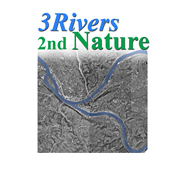Home> River Research> Allegheny River> Botany
Allegheny River Botany Report
Professor Susan Kalisz | Jessica Dunn
University of Pittsburgh, Department of Biological Sciences
In 2002, Pools 1, 2, 3 and part of Pool 4 of the Allegheny River were the focus of the data collection effort. The length of the river studies were divided into one-tenth of a mile segments. Sampling locations were located through a hand-held GPS unit. As in 2001, we focused on determining the presence and relative abundance of the woody vegetation because they are diagnostic of plant community types. When present, emergent woody and herbaceous aquatic vegetation was also recorded. Our primary survey method of the riverbank woody vegetation involved scanning the riverbank from the 3R2N vessel. We surveyed all woody vegetation from the shoreline to approximately twenty feet back from the river edge.
Conclusions
- Four native woody plant communities and one native herbaceous plant community typical of large rivers in North America are found along both Monongahela and Allegheny Rivers.
- Although the same communities can be found along the Monongahela and Allegheny Rivers, the two rivers differ in which native communities are most common. Since floodplain forests are globally endangered, these forests contribute to regional and national biodiversity. This information can be used to direct conservation and restoration efforts along our rivers.
- Including Japanese knotweed, introduced species comprise 17-18% of woody plants along both the Allegheny and Monongahela Rivers. However, a lower proportion of those are both introduced and invasive.
- The frequency of invasive species decreases with distance from Point State Park on both the Allegheny and Monongahela Rivers, suggesting that human disturbance may be facilitating invasion or maintenance of invasive species once introduced.
- Tree of heaven and Japanese knotweed are the most common invasive species found to date in our database.
- Japanese knotweed, a species of great public concern, is found throughout the surveyed area at high abundances and poses a threat to our native species. It has increased in abundance in our sampling area even over the short span of this project. Serious eradication efforts are required to prevent further spreading and domination of this species.
- The islands of the Allegheny River support four of the five community types found on the riverbanks. Public use planning for these islands can provide opportunities to enhance the natural beauty of Pittsburgh, adding to the scenic quality of the rivers and potentially providing a recreational resource.
As in 2000 and 2001 studies, additional data on non-woody species was collected for a small number of species or plant functional groups. Three of these plants, Justicia Americana, Iris psuedacorus, and Lythrum salicaria, were mapped and geo-referenced. These herbaceous plants are useful indicator species, plants of special concern or invasive. This baseline data can be used to monitor spread or decline of these species in the future.
Justicia americana (water willow) is a native aquatic species found along edges of lakes, ponds, and streams. It usually indicates a healthy and intact riparian zone and is the dominant member of the Waterwillow - Smartweed Community. Iris pseudacorus (yellow iris) is an introduced species also found along edges of lakes, ponds, and streams. I. pseudacorus was often found growing near acid mine drainage in the Monogahela pools studied in 2001 but was rarely found on the Allegheny River, where there is little acid mine drainage. Lythrum salicaria (purple loose-strife) is a highly invasive species that was introduced to the United States from Europe. Here it is co-occuring with the native floodplain species Lobelia cardinalis(cardinal flower). It is found in scattered areas along our Pittsburgh Rivers and can be closely monitored for spread using this geo-referenced system.


